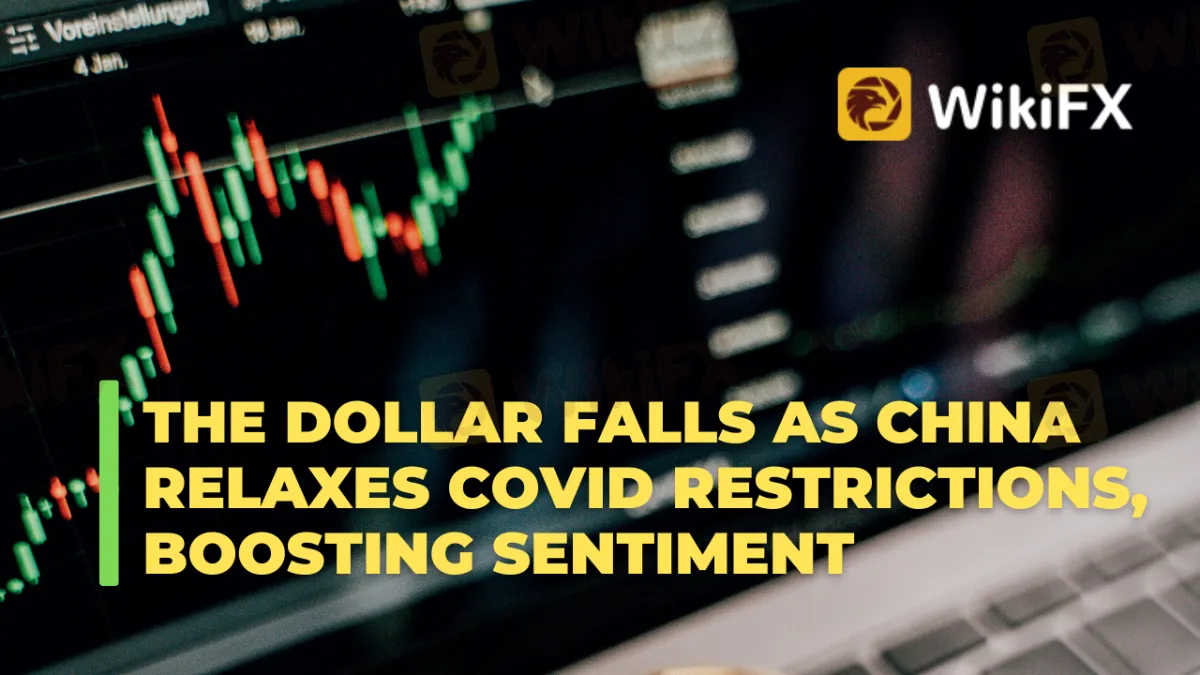简体中文
繁體中文
English
Pусский
日本語
ภาษาไทย
Tiếng Việt
Bahasa Indonesia
Español
हिन्दी
Filippiiniläinen
Français
Deutsch
Português
Türkçe
한국어
العربية
The Dollar Falls As China Relaxes COVID Restrictions, Boosting Sentiment
Abstract:The dollar fell across the board on Monday as traders poured into riskier assets as additional Chinese cities removed certain COVID-related restrictions, raising optimism about the world's second-largest economy reopening.

The dollar fell across the board on Monday as traders poured into riskier assets as additional Chinese cities removed certain COVID-related restrictions, raising optimism about the world's second-largest economy reopening.
Following recent, unprecedented demonstrations against the government's hardline “dynamic zero-COVID” plan, financial center Shanghai and Urumqi in the far west announced a relaxation of coronavirus limits over the weekend.
“They may seem to be small steps, but they are a significant indication of China taking measured moves toward openness,” said Christopher Wong, a currency analyst at OCBC in Singapore.

According to those acquainted with the situation, China is about to announce a countrywide relaxation of testing regulations, as well as enabling positive patients and close contacts to isolate at home under specific situations.
The dollar fell below 7.0 yuan in offshore trading, while the onshore yuan rose 1.4% to as high as 6.9507 on Monday morning, its highest level since September 13.
The dollar index, which compares the greenback to six major currencies, including the yen and euro, was down 0.268% at 104.19, its lowest level since June 28.
The index dropped 1.4% last week and 5% in November, its lowest month since 2010. The current dollar bearishness arose mostly from predictions that the Federal Reserve may slow the pace of its interest rate rises following four straight 75 basis point increases.
Investors will be looking for consumer price inflation data in the United States on December 13, one day before the Fed's two-day policy meeting finishes.
At the meeting, the Fed is likely to raise interest rates by another 50 basis points. Fed funds futures traders now expect the Fed's benchmark rate to reach 4.92% in May.
According to Wong of OCBC, some caution is still necessary since the Fed is not done tightening. “They're still tightening; it'll just be in modest increments.”
Meanwhile, the Japanese yen fell 0.20% against the US dollar to 134.59 per dollar, after rising 3.5% in the previous week and still far below October's low of 151.94.
The yen's rise coincides with a focus on the difficulties of protracted monetary easing policies, as well as a Bank of Japan leadership change when governor Haruhiko Kuroda, considered a policy dove, completes his second term.
According to its board member Naoki Tamura, the BOJ should undertake a review of the monetary policy framework and adjust its huge stimulus program based on the findings.
“You have a situation not just of the Fed reducing its rate of policy tightening, but also of the possible BOJ unwinding, maybe at an early stage, part of its extraordinarily accommodating policies,” Wong said.
“The two factors coming from both sides might offer the dollar/yen a little more downside... the dollar/yen still has the opportunity to test lower.”
The euro jumped 0.32% to $1.0572 after rising 1.3% the previous week. It had previously reached a five-month high of $1.05835.
Sterling reached a high of $1.23450, its highest level since June 17, and was last trading at $1.2327, up 0.33% on the day.
The Australian dollar was up 0.59% at $0.683, while the New Zealand dollar was up 0.31% at $0.643.
Stay tuned for more Forex News.
Download the WikiFX App from the App Store or Google Play Store to stay updated on the latest news.

Disclaimer:
The views in this article only represent the author's personal views, and do not constitute investment advice on this platform. This platform does not guarantee the accuracy, completeness and timeliness of the information in the article, and will not be liable for any loss caused by the use of or reliance on the information in the article.
Read more

Top 10 Trading Indicators Every Forex Trader Should Know
Master the top 10 Forex trading indicators to analyze real-time Forex quotes, trends, and market signals. Learn strategies to boost accuracy and avoid mistakes.

Geopolitical Events: What They Are & Their Impact?
You've heard many times that geopolitical events have a significant impact on the Forex market. But do you know what geopolitical events are and how they affect the FX market? Let us learn about it today.

Why Do You Feel Scared During Trade Execution?
Trade execution is a pivotal moment for traders. It is when analysis turns into action, and potential profits or losses become reality. However, for many traders, this moment is accompanied by fear. Why does this happen, and how can you address it?

WikiEXPO Global Expert Interview: Simone Martin—— Exploring Financial Regulation Change
In the midst of financial innovation and regulation, WikiGlobal, the organizer of WikiEXPO, stays abreast of industry trends and conducts a series of insightful and distinctive interviews on pivotal topics. We are delighted to have the privilege of inviting Simone Martin for an in-depth conversation this time.
WikiFX Broker
Latest News
Volkswagen agrees deal to avoid Germany plant closures
Geopolitical Events: What They Are & Their Impact?
Top 10 Trading Indicators Every Forex Trader Should Know
TradingView Launches Liquidity Analysis Tool DEX Screener
MultiBank Group Wins Big at Traders Fair Hong Kong 2024
WikiEXPO Global Expert Interview: Simone Martin—— Exploring Financial Regulation Change
'Young investors make investment decisions impulsively to keep up with current trends' FCA Reveals
Why Do You Feel Scared During Trade Execution?
CySEC Settles Compliance Case with Fxview Operator Charlgate Ltd
Scope Markets Review: Trustworthy or Risky?
Currency Calculator


